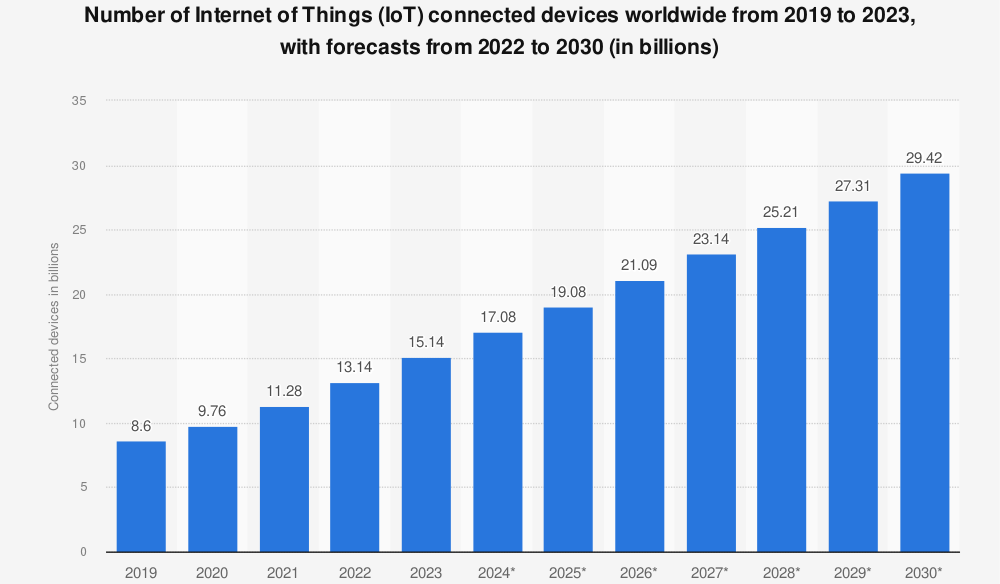The Internet of Things (IoT) has dramatically transformed how we interact with everyday objects and manage complex systems. This technological revolution is driven by the ability of devices to connect, communicate, and operate cohesively, generating vast amounts of data that can be analysed and acted upon in real time. To harness the full potential of IoT, businesses are increasingly turning to IoT Software as a Service (SaaS) platforms. These cloud-based solutions provide comprehensive tools for device management, data analytics, and application development, all delivered as a service over the internet.
Choosing the right IoT SaaS platforms will be crucial for businesses looking to optimise their operations, reduce costs, and enhance customer experiences. This blog explores some of the top IoT SaaS platforms available today, highlighting their key features and benefits.
Best IoT SaaS Platforms
The rapid adoption of Internet of Things (IoT) technologies has led to the development of various IoT Software as a Service (SaaS) platforms, each offering unique features. Here, we explore the key features of the best IoT SaaS platforms available today:
Amazon Web Services (AWS) IoT
Key Features:
Device Management: AWS IoT Device Management helps you securely onboard, organise, monitor, and remotely manage IoT devices at scale.
Data Analytics: AWS IoT Analytics provides advanced analytic services for large-scale IoT applications.
Security: AWS IoT offers robust security features, including device authentication, data encryption, and secure communication channels.
Machine Learning Integration: Seamlessly integrates with AWS Machine Learning services for enhanced predictive analytics.
Appscrip SaaS IoT Platform
Appscrip’s IoT SaaS platform is designed to provide comprehensive solutions for managing IoT devices, collecting and analysing data, and integrating with other systems to enhance business operations.
Device Management
Onboarding and Configuration: Simplifies the process of onboarding new devices and configuring them for optimal performance.
Monitoring and Diagnostics: Provides real-time monitoring and diagnostics to ensure devices are functioning correctly.
Remote Management: Allows for remote management and control of IoT devices, including firmware updates and troubleshooting.
Data Analytics
Real-time Data Processing: Enables real-time data processing to provide immediate insights and actions.
Advanced Analytics: Offers tools for advanced data analytics, including predictive analytics and machine learning integration.
Customisable Dashboards: Customisable dashboards for visualising data and generating reports tailored to specific business needs.
Scalability
Elastic Scaling: Supports elastic scaling to accommodate increasing numbers of connected devices and data volumes.
Cloud-based Infrastructure: Leverages cloud infrastructure to provide scalable and reliable services.
Security
Data Encryption: Ensures that all data transmitted between devices and the cloud is encrypted to protect against unauthorised access.
Authentication and Authorisation: Implements robust authentication and authorisation mechanisms to secure device access and data integrity.
Compliance: Adheres to industry standards and compliance requirements to ensure data security and privacy.
Integration
API Integration: Offers extensive API integration capabilities to connect with other enterprise systems and third-party applications.
IoT Protocol Support: Supports a wide range of IoT protocols such as MQTT, CoAP, and HTTP for seamless device communication.
Ecosystem Compatibility: Compatible with various IoT ecosystems and platforms, enabling interoperability and flexibility.
User-Friendly Interface
Intuitive Dashboard: Provides an intuitive and user-friendly dashboard for managing devices, monitoring data, and configuring settings.
Easy Setup: Facilitates easy setup and deployment of IoT solutions, reducing time to market.
Mobile Access: Mobile-friendly interface allows users to manage and monitor their IoT solutions on the go.
Automation and Alerts
Automated Workflows: Enables the creation of automated workflows to respond to specific events or conditions.
Alerts and Notifications: Configurable alerts and notifications to inform users of critical events, anomalies, or required actions.
Microsoft Azure IoT
Key Features:
Comprehensive Suite: Azure IoT Suite includes device management, data analytics, and machine learning capabilities.
Scalability: Easily scale your IoT solutions to accommodate growing data volumes and connected devices.
Integration: Integrates with other Azure services such as Azure Machine Learning and Azure Cognitive Services for advanced data processing and insights.
Security: Built-in security features, including Azure Security Center for IoT, to protect IoT deployments.

Oracle IoT
Key Features:
Real-time Data Processing: Oracle IoT provides real-time data processing capabilities for actionable insights.
Integrated Cloud Services: Integrates seamlessly with Oracle Cloud services for enhanced data management and analytics.
Comprehensive Device Management: Offers extensive device management features, including device monitoring, diagnostics, and updates.
Security: Robust security protocols to ensure data integrity and secure communication.
IRI Voracity
Key Features:
Data Management: Powerful data management capabilities, including data integration, migration, and transformation.
Analytics and Visualization: Advanced analytics and data visualisation tools to derive actionable insights from IoT data.
Security and Compliance: Ensures data security and compliance with industry standards.
Scalability: Supports large-scale data processing and management for extensive IoT deployments.
ThingWorx IIoT Platform
Key Features:
End-to-End Solution: Provides an end-to-end solution for industrial IoT, from device connectivity to data analytics and visualisation.
Rapid Application Development: Enables rapid development of IoT applications with its model-based development environment.
Integration: Integrates with various enterprise systems and IoT devices for seamless data flow and management.
Security: Comprehensive security features to protect data and ensure secure communication across IoT networks.
Factors To Consider While Choosing IoT SaaS Platform
Choosing the right IoT SaaS platform is a critical decision for any business looking to leverage the power of the Internet of Things. Here are several key factors to consider when selecting an IoT SaaS platform:
Scalability and Flexibility: Scalability is essential as your IoT deployment grows over time, requiring the platform to accommodate more devices and larger volumes of data without performance degradation.
Flexibility in terms of technology is crucial to adapt to evolving IoT standards and protocols.
Pricing Model and Business Case: Evaluate the pricing model carefully, considering both initial costs and long-term expenses as your IoT needs expand. Some platforms may offer low initial costs but become expensive as you scale.
The business case for the platform should align with your organisational goals and financial planning.
Security: Look for platforms designed with security by design, covering aspects from device-to-cloud network security, authentication, certificates, and data encryption to ensure the integrity and confidentiality of your IoT data.
Time to Market: Consider platforms that offer tools or packages to accelerate product development, thus reducing the time to market for your IoT solutions.

Data Ownership and Privacy: Understand the policies related to data ownership and how they align with legal regulations in your jurisdiction. This includes knowing who owns the data generated by your devices and its use.
Attractive Interface: An intuitive user interface is vital for widespread adoption within your organisation, ensuring that both technical and non-technical staff can efficiently use the platform.
Application Environment: The ability to develop and deploy applications directly on the platform can significantly speed up IoT deployment. Assess the application development environment and existing IoT apps for compatibility and ease of use.
Platform Migration: Future-proof your investment by considering the ease of platform migration. Well-documented APIs and schemas can facilitate a smooth transition if your needs outgrow the platform.
Hybrid Cloud: For some businesses, a hybrid cloud approach that supports processing sensitive data locally while offloading less critical operations to the cloud can be beneficial.
Data Analytics and Visualisation: Not all platforms come with built-in data analytics and visualisation tools. Look for platforms that offer comprehensive data processing capabilities or can seamlessly integrate with external analytic services.
Protocol Support: Ensure the platform supports a wide range of IoT protocols, such as MQTT, HTTP, AMQP, and CoAP, to ensure compatibility with various devices and services.
System Performance: Assess the platform’s capacity for optimising and maintaining performance, especially while handling high volumes of data and connections.
Interoperability: The platform should function well as a middleware layer, integrating smoothly with other systems and devices to ensure interoperability across your IoT ecosystem.
Bandwidth: Consider the platform’s ability to manage bandwidth efficiently, ensuring low latency and high throughput for real-time IoT applications.
Edge Intelligence and Control: With the growth of edge computing, evaluate whether the platform incorporates edge capabilities, allowing for local data processing and decision-making at the device level.
Conclusion
Selecting the right IoT SaaS platform is a pivotal decision that can significantly impact the success of your IoT initiatives. By carefully evaluating factors such as scalability, security, data analytics, and integration capabilities, businesses can ensure they choose a platform that not only meets their current needs but also adapts to future technological advancements and growing demands.
The right IoT SaaS platform will empower your organisation to harness the full potential of IoT, driving innovation, efficiency, and competitive advantage.
If you’re looking for a comprehensive, scalable, and secure IoT SaaS platform, look no further than Appscrip’s IoT SaaS Platform. With its extensive suite of features, including robust device management, real-time data analytics, and seamless integration capabilities, Appscrip’s platform is designed to meet the diverse needs of modern businesses.
Get started with Appscrip’s IoT SaaS Platform today and take the first step towards a smarter, more connected future!



